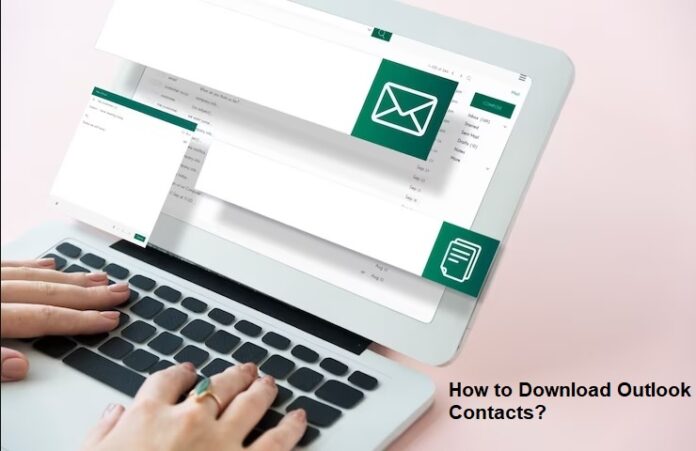Do you know How to Download Outlook Contacts? Outlook is a popular email and personal information management application by Microsoft. This easily allows users to store and manage their contacts efficiently. Contacts are a crucial part of any professional or personal communication, and having a backup or downloading them is essential. Let us see a step-by-step process of downloading Outlook contacts to ensure that you have a secure backup or the ability to transfer them to another platform or device.
To download Outlook contacts, you first need to access the Contacts section within Outlook. Here’s how:
a. Launch Outlook: Open the Outlook application on your computer or access it through your web browser by visiting the Outlook website and signing in to your account.
b. Navigate to the Contacts Section: Look for the “Contacts” tab or icon, usually located in the bottom-left corner or on the navigation pane. Click on it to access your contacts.
1. Exporting Outlook Contacts to a CSV File:
Table of Contents
CSV (Comma-Separated Values) is a widely used file format that can be easily imported into various applications and platforms. To export your Outlook contacts to a CSV file, follow these steps:
a. Select Contacts: In the Contacts section, select the contacts you want to export. You can choose individual contacts or use Ctrl+A (Command+A on Mac) to select all contacts.
b. Open the Export Wizard: Locate the “File” tab at the top-left corner of the Outlook window and click on it. In the drop-down menu, section please select “Open & Export” and then you need to click on the “Import/Export.” option you see.
c. Choose Export to a File: In the Import and Export Wizard window, select “Export to a file” and click on the “Next” button.
d. Select CSV as the File Type: In the next window, choose “Comma Separated Values” and click on “Next.”
e. Choose the Contacts Folder: Select the “Contacts” folder from the list of available folders and click on “Next.”
f. Specify the File Name and Location: Choose a location on your computer where you want to save the exported CSV file and provide a name for the file. Click on “Finish” to start the export process.
g. Map Fields (Optional): If prompted, you can map the fields from your Outlook contacts to the appropriate fields in the CSV file. This step ensures that the exported data is accurately formatted. Click on “Finish” once the field mapping is complete.
2. Exporting Outlook Contacts to a PST File:
PST (Personal Storage Table) is a file format specific to Microsoft Outlook, used for storing emails, contacts, calendar items, and other data. Exporting your Outlook contacts to a PST file can be useful for creating a complete backup or for transferring contacts to another Outlook account. Here’s how to export contacts to a PST file:
a. Access the Import/Export Wizard: Open the Import and Export Wizard by following the steps mentioned in Section 2, steps b and c.
b. Choose Export to a File: In the Import and Export Wizard window, select “Export to a file” and click on the “Next” button.
c. Select Outlook Data File (.pst): Choose “Outlook Data File (.pst)” as the export file type and click on “Next.”
d. Choose the Contacts Folder: Select the “Contacts” folder from the list of available folders and click on “Next.”
e. Specify the File Name and Location: Select a location on your computer where you want to save the exported PST file and provide a name for the file. Optionally, you can also set password protection for the file. Now Click on “Finish” to begin the export procedure.
f. Set Export Options (Optional): If prompted, you can set options for the export process, such as excluding duplicates or specifying date ranges. Customize the options as per your requirements and click on “Finish” to proceed.
3. Exporting Outlook Contacts to a vCard File:
vCard is a widely supported file format for storing contact information. Exporting your Outlook contacts to a vCard file allows you to easily import them into other applications or devices that support vCard format. Follow these steps to export contacts to a vCard file:
a. Open the Import/Export Wizard: Access the Import and Export Wizard as explained in Section 2, steps b and c.
b. Choose Export to a File: In the Import and Export Wizard window, select “Export to a file” and click on the “Next” button.
c. Select vCard (folder) as the File Type: Choose “vCard (folder)” as the export file type and click on “Next.”
d. Choose the Contacts Folder: Select the “Contacts” folder from the list of available folders and click on “Next.”
e. Specify the File Name and Location: Select a location on your computer where you want to save the exported vCard file and provide a name for the file. Click on “Finish” to start the export process.
4. Exporting Outlook Contacts to Excel:
If you prefer to have your Outlook contacts in an Excel spreadsheet, you can export them directly to an Excel file. This allows for easy manipulation and organization of the contact data. Here’s how to export contacts to Excel:
a. Open the Import/Export Wizard: Access the Import and Export Wizard following the steps mentioned in Section 2, steps b and c.
b. Choose Export to a File: In the Import and Export Wizard window, select “Export to a file” and click on the “Next” button.
c. Select Microsoft Excel as the File Type: Choose “Microsoft Excel” as the export file type and click on “Next.”
d. Choose the Contacts Folder: Select the “Contacts” folder from the list of available folders and click on “Next.”
e. Specify the File Name and Location: Select a location on your computer where you want to save the exported Excel file and provide a name for the file. Click on “Finish” to initiate the export process.
f. Set Excel Options (Optional): If prompted, you can customize options for the exported Excel file, such as including field headers or excluding empty fields. Adjust the options as needed and click on “Finish” to proceed.
5. Troubleshooting Common Issues:
a. Missing or Incomplete Contacts: If you notice that some contacts are missing or the exported file does not contain all the desired information, ensure that you have selected the correct contacts folder for export. Double-check your selection and try the export process again.
b. File Corruption: In rare cases, exported files may become corrupted or unreadable. To minimize the risk of file corruption, ensure that your Outlook application is up to date. If you encounter file corruption, try exporting the contacts again or contact Microsoft support for assistance.
c. Compatibility Issues: Depending on the file format you choose for export, you may encounter compatibility issues when importing the contacts into other applications or platforms. Ensure that the target application or platform supports the file format you are exporting to.
Conclusion:
Downloading Outlook contacts is a valuable practice to safeguard your important contact information or to transfer them to another platform or device. By following the step-by-step instructions provided in this guide, you can easily export your Outlook contacts to various file formats such as CSV, PST, vCard, or Excel. Having a backup of your contacts ensures that you can retrieve and manage them efficiently, even in the event of data loss or platform transitions.











